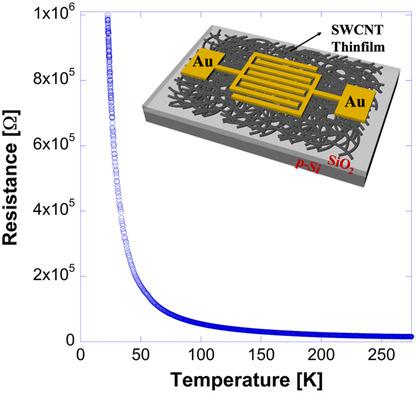当前位置:
X-MOL 学术
›
Phys. Status Solidi A
›
论文详情
Our official English website, www.x-mol.net, welcomes your
feedback! (Note: you will need to create a separate account there.)
Temperature‐Dependent Electrical Transport Properties of Single‐Walled Carbon Nanotube Thin Films Prepared by Electrohydrodynamic Atomization Technique
Physica Status Solidi (A) - Applications and Materials Science Pub Date : 2020-05-27 , DOI: 10.1002/pssa.202000029 Gunasekaran Venugopal 1, 2 , Yuvaraj Sivalingam 3 , Sridharan Sundharam 4 , Devaraju Murukanahally Kempaiah 5 , Sang-Jae Kim 6 , Kónya Zoltán 1
Physica Status Solidi (A) - Applications and Materials Science Pub Date : 2020-05-27 , DOI: 10.1002/pssa.202000029 Gunasekaran Venugopal 1, 2 , Yuvaraj Sivalingam 3 , Sridharan Sundharam 4 , Devaraju Murukanahally Kempaiah 5 , Sang-Jae Kim 6 , Kónya Zoltán 1
Affiliation

|
Herein, the temperature‐dependent electrical transport properties of single‐walled carbon nanotube (SWCNT) thin films prepared by the electrohydrodynamic atomization technique, are reported. The physico–chemical properties of SWCNT thin films are characterized using X‐ray diffraction, Raman, transmission electron, and field‐emission scanning electron microscopy techniques. The electrical transport measurements are carried out from 285 to 20 K. A semiconducting behavior is observed when the temperature goes down to 20 K. The prevalent transport mechanism is analyzed with a variable‐range hopping model, which is well aided by Raman analysis. Furthermore, the thermal dependence of the electrical conductivity of the SWCNT thin film is investigated using the Arrhenius model, which reveals the conductivity of the SWCNT thin film at low‐temperature shows in the order of mega‐Ohm resistance with a small activation energy of 1.81 J mol−1, and an exponential decrement in conductivity is observed while decreasing the temperature to 20 K, which further confirms the semiconducting behavior of the SWCNT thin film. The Poole–Frenkel conduction mechanism shows best fit for the temperatures 50, 75, and 100 K, and the results provide potential insights into the science and development of SWCNT research.
中文翻译:

电流体雾化技术制备的单壁碳纳米管薄膜的温度依赖性电输运性质
本文报道了通过电流体动力学雾化技术制备的单壁碳纳米管(SWCNT)薄膜随温度变化的电传输特性。利用X射线衍射,拉曼光谱,透射电子和场发射扫描电子显微镜技术对SWCNT薄膜的物理化学性质进行了表征。电迁移的测量范围是从285到20K。当温度降至20 K时,可以观察到半导体行为。使用可变范围跳变模型分析了普遍的传输机制,这在拉曼分析的帮助下非常有用。此外,使用Arrhenius模型研究了SWCNT薄膜电导率的热依赖性,-1,并且在将温度降低至20 K的同时观察到电导率呈指数下降,这进一步证实了SWCNT薄膜的半导体特性。Poole-Frenkel传导机制最适合50、75和100 K的温度,其结果为SWCNT研究的科学和发展提供了潜在的见识。
更新日期:2020-05-27
中文翻译:

电流体雾化技术制备的单壁碳纳米管薄膜的温度依赖性电输运性质
本文报道了通过电流体动力学雾化技术制备的单壁碳纳米管(SWCNT)薄膜随温度变化的电传输特性。利用X射线衍射,拉曼光谱,透射电子和场发射扫描电子显微镜技术对SWCNT薄膜的物理化学性质进行了表征。电迁移的测量范围是从285到20K。当温度降至20 K时,可以观察到半导体行为。使用可变范围跳变模型分析了普遍的传输机制,这在拉曼分析的帮助下非常有用。此外,使用Arrhenius模型研究了SWCNT薄膜电导率的热依赖性,-1,并且在将温度降低至20 K的同时观察到电导率呈指数下降,这进一步证实了SWCNT薄膜的半导体特性。Poole-Frenkel传导机制最适合50、75和100 K的温度,其结果为SWCNT研究的科学和发展提供了潜在的见识。











































 京公网安备 11010802027423号
京公网安备 11010802027423号